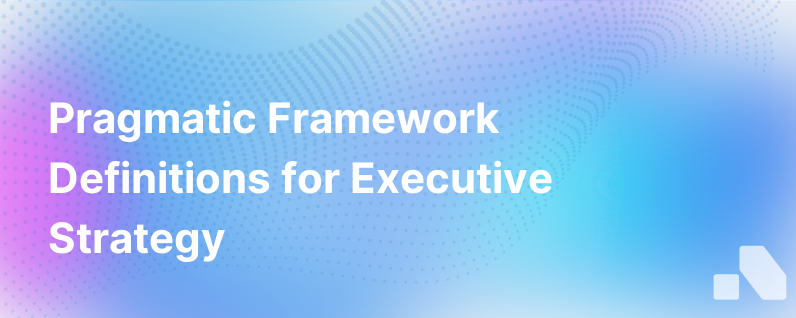
In the fast-paced business environment of today, companies seek robust methodologies that can help them navigate complexities while remaining adaptable to changing market conditions. The Pragmatic Framework exists as one such multifaceted guide, designed to create and market products with practicality and efficiency. This framework is like a compass for product management and marketing teams to steer their efforts in a direction that nearly guarantees success if followed with diligence. In this detailed exploration, we dive into the definitions and applications of this pivotal system.
Understanding the Pragmatic Framework
The Pragmatic Framework, established by Pragmatic Institute (formerly Pragmatic Marketing), is a proven blueprint structured to support businesses in crafting and marketing products that customers want and will buy. Comprising numerous activities categorized across different functions, the framework serves as a detailed checklist to ensure that every aspect of product management and marketing is covered.
From ideation to delivery, and from strategy to execution, it chronologically lays down the path one should take for effective product management. Its strength lies in its versatility – capable of being tailored to suit startups, mid-size businesses, and large enterprises across varied industries.
The Core Elements of the Pragmatic Framework
A pragmatic approach implies a practical, results-oriented method, and that's precisely what the Pragmatic Framework reflects through its core elements:
Market Understanding: This is the beginning—where a business studies its audience's needs, pain points, and buying patterns. It defines the importance of market research, segmentation, and buyer personas.
Strategy Development: Here, companies outline their product vision, set actionable goals, and establish differentiation strategies to stand out in the marketplace. The framework suggests using market data to inform strategic moves and product roadmaps.
Product Development: With a firm grasp on market needs and a clear strategy, businesses move on to the actual product creation. This includes requirements management, prototyping, prioritizing features, and agile methodologies for continuous improvement.
Go-to-Market: The Pragmatic Framework emphasizes crafting compelling narratives that resonate with target audiences. It encompasses pricing models, distribution channels, sales enablement, and launch plans.
Sales and Marketing: This area of the framework addresses promotion, lead generation, positioning, and the alignment of sales and marketing efforts to ensure coherence in how the product is presented and sold to the market.
Supporting Processes: Ensuring that teams have the right tools, technologies, and processes in place is critical for seamless execution. Support mechanisms like project management, data analytics, and customer feedback loops are integral components of the framework.
The Lifecycle Management: Products must evolve to stay relevant, necessitating lifecycle management that includes market monitoring, customer experience management, and planned end-of-life strategies for products.
Implementing the Pragmatic Framework
Putting the Pragmatic Framework to work requires a systematic approach:
-
Align with Business Objectives: Start by aligning framework activities with overall business goals. It ensures efforts are directed toward the company’s broader aspirations.
-
Define Roles and Responsibilities: Clearly define who is responsible for each activity within the framework to maintain a high degree of accountability.
-
Continually Educate Teams: Foster continuous learning and improvement amongst teams using the framework as a basis for training and skill development.
-
Monitor and Adapt: Use defined key performance indicators (KPIs) to measure the effectiveness of actions taken and be willing to adapt strategies based on these insights.
-
Cultivate Communication: Maintain open channels for feedback across departments to develop a cohesive understanding of the framework’s function and progress.
Real-World Applications
Consider a SaaS company venturing into a new market segment; it leverages the Pragmatic Framework to understand the competitive landscape (Market Understanding), differentiates its product by focusing on unique user experience (Strategy Development), iteratively adds features based on customer feedback (Product Development), employs a freemium pricing model for initial user acquisition (Go-to-Market), and uses targeted content marketing to foster leads (Sales and Marketing).
Another example might be a consumer goods company, which relies on the Pragmatic Framework to tackle a declining product line. It revisits its market research to capture changing preferences (Market Understanding), shifts its strategy to cater to eco-conscious buyers (Strategy Development), remodels its product using sustainable materials (Product Development), positions this new line as 'green' with appropriate branding (Go-to-Market), and integrates customer testimonials for social proof in its campaigns (Sales and Marketing).
Conclusion
The Pragmatic Framework stands as a testament to the power of structured, versatile, and adaptable methodologies in the unpredictable realm of product management and marketing. Its systematic nature allows for a clear division of responsibilities, ensuring that everyone from product managers to marketers, sales professionals to executives, is on the same page.
In a world where markets evolve rapidly and consumer preferences shift overnight, the Pragmatic Framework serves as a pivotal anchor. It gracefully combines the theoretical with the tangible, ensuring that practicality reigns in the quest to not just meet but anticipate and redefine customer demands.
For organizations intent on not just weathering storms but charting a course for clear waters, the Pragmatic Framework is the compass by which to set sail—a testament to the meticulous planning and strategic execution that elevates products from mere concepts to market successes. As frameworks go, Pragmatic’s is a blueprint for a product's life well-lived—from conception, through growth, and, eventually, to evolution.